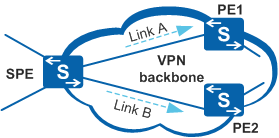Configuring VPNv4 FRR
Context
In an HVPN scenario in which VPNv4 FRR is configured, if the active LSP between an SPE and its next hop is unreachable, traffic can be rapidly switched to the standby LSP for transmission.
Figure 1 shows an HVPN network. On the network, VPNv4 FRR is configured on the SPE. If the LSP (Link A) from the SPE to PE1 fails, traffic is automatically switched to the LSP (Link B) from the SPE to PE2, to minimize the impact of the link failure on VPN services.
VPNv4 FRR is deployed in different locations on HVPN networks:
-
On an HVPN network, VPNv4 FRR is deployed on SPE nodes.
Procedure
- Run system-view
The system view is displayed.
- Run bgp { as-number-plain | as-number-dot }
The BGP view is displayed.
- Run ipv4-family vpnv4
The BGP-VPNv4 address family view is displayed.
- Run auto-frr
VPNv4 FRR is enabled.
- Run bestroute nexthop-resolved tunnel
The system is configured to select a VPNv4 route only when the next hop is iterated to a tunnel. This configuration prevents packet loss during a revertive switchover.
